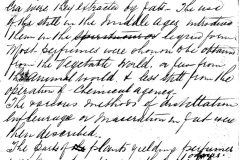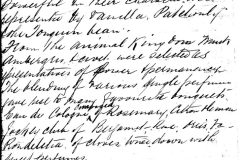Perfumes Pleasant & otherwise by T. J. Hasselby
The lecturer commenced the history of perfumes with a notice of their first known use in the Jewish religious services. At first, they were used either in the (???) or powdered form, & not till the Christian era were they extracted by fats. The use of the still in the Middle Ages introduced them I the liquid form. Most perfumes were shown to ne obtained from the vegetable world, a few from the animal world & less still from the operation of chemical agency.
The various methods of distillation enfleurage or maceration in fat were then described. The parts of plants yielding perfumes were passed in review the richest odours being obtained from flowers – while others were produced from the leaf – the wood the bark & the root.
The Rose as the Queen of Flowers yielding Oils & Essence, Lavender oil first of English flowers yielding the favourite perfume. Rosemary so valuable to the Cologne maker, the Orange order yielding more varied perfumes than any other were described, Tukerost Jasmin closing the section of European products.
Eastern Perfumes rich cloying & powerful in their character were represented by Vanilla, Patchouly & the Tonquin bean.
From the animal kingdom musk Ambergris & Civet were selected as representations of power & permanence.
The blending of various single perfumes gave rise to many favourite bouquets, Eau de Cologne comprised of Rosemary, Citton & Lemon, Jockey club of Bergamot, Rose, Orris etc. – Rondeletia of Cloves tones down with sweet perfumes.
The unpleasant perfumes were principally obtained from the chemical world, & were generally dangerous to life, the hydroglus being specimens of that class. The lecture was illustrated by a variety of perfumes placed at the disposal of the audience for practical examination & use.
[The following is a copy from the minute book of a brief note on the presentation of this paper]
Mr. T.J. Hasselby read a paper on “Perfumes, pleasing & otherwise.”
In the course of a pleasant & instructive lecture Mr. Hasselby gave an exhaustive descriptive of the more important natural perfumes of both vegetable & animal origin, describing their sources, methods of production & peculiarities. Specimens of nearly every perfume named were passed round for the inspection (& where suitable for the use) of the audience.
In the production of simple odours 3 processes were chiefly employed. Distillation with water or steam as in oil of Lavender; Pressure of the scraped Rind as in oil of Lemon; Enfleurage or the absorption of the odour by fat as in Violet & Jasmin Perfumes. Compound odours or Bouquets are produced by the judicious blending of natural perfumes & even simple perfumes such as Violet & White Rose have their fragrance enhanced & rendered more permanent by careful mixing with others suitable scents.

